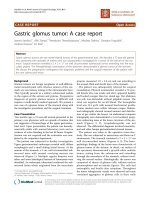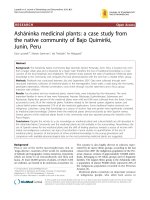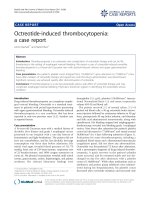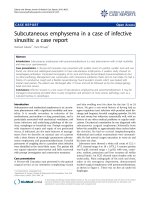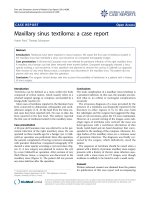Báo cáo y học: "Cornual heterotopic pregnancy: a case report" ppt
Bạn đang xem bản rút gọn của tài liệu. Xem và tải ngay bản đầy đủ của tài liệu tại đây (725.71 KB, 4 trang )
Case report
Open Access
Cornual heterotopic pregnancy: a case report
Olivier Poujade*, Gu illaume Ducarme and Dominique Luton
Address: Department of Gynecology and Obstetrics, Hôpital Beaujon, Bld du Général Leclerc, 92110 Clichy, France
Email: OP* - ; GD - ; DL -
* Corresponding author
Received: 1 August 2008 Accepted: 22 January 2009 Published: 23 June 2009
Journal of Medical Case Reports 2009, 3:7233 doi: 10.4076/1752-1947-3-7233
This article is available from: />© 2009 Poujade et al; licensee Cases Network Ltd.
This is an Open Access article distributed under the terms of the Creative Commons Attribution License (
/>which permits unrestricted use, distribution, and reproduction in any medium, provided the original work is properly cited.
Abstract
Introduction: Cornual heterotopic pregnancy is a very rare condition; its incidence remains
unknown. We report a case of cornual heterotopic pregnancy managed by laparoscopy and guided
methotrexate injection into the cornual sac.
Case presentation: A cornual heterotopic pregnancy was diagnosed at 9 weeks of amenorrhoea in
a 31-year-old healthy woman. Ultrasound examination showed a well-formed intrauterine gestation
without detectable fetal heart pulsation, together with a gestational sac situated in the right cornual
region. After uterine evacuation under ultrasound guidance, the diagnosis of cornual pregnancy was
confirmed on laparoscopy followed by methotrexate injection into the cornual gestational sac.
Conclusions: Cornual heterotopic pregnancy is a very rare and potentially dangerous condition.
Diagnosis of cornual pregnancy could be made on ultrasound examination in this patient.
Laparoscopy was useful as an alternative in confirming the diagnosis and aided further treatment.
Introduction
Heterotopic pregnancy is defined as the coexistence of
intrauterine pregnancy and ectopic pregnancy. The
incidence of heterotopic pregnancy is estimated to be
1/30,000 in spontaneous pregnancy but much higher
than 1/3600 to 1/100 when associated with in vitro
fertilization (IVF) according to more recent literature. It
is probably in the range of 1% to 3% [1,2].
Cornual pregnancy occurs at the funnel-shaped area in the
upper uterine body that receives the insertion of the
Fallopian tubes [3], the cornual region of the uterus. Its
occurrence rate ranges from 1/2500 to 1/5000 live births
and represents 1% of ectopic pregnancies [4].
The incidence of heterotopic pregnancy with extrauterine
gestation located in the cornual area is not known,
nevertheless, the incidence of cornual heterotopic preg-
nancy is estimated to be 1/3600 IVF pregnancies [5]. We
present one case of spontaneous cornual heterotopic
pregnancy diagnosed by ultrasound, and managed by
laparoscopic-guided methotrexate injection into the
cornual sac.
Case presentation
A healthy 31-year-old woman presented at 9 weeks of
amenorrhoea with spotting and lower abdominal pain.
She had a previous history of four term pregnancies and
one spontaneous abortion, and her current pregnancy
Page 1 of 4
(page number not for citation purposes)
occurred spontaneously. Her vital signs were stable, and
physical examination revealed a slight pain in the right
lower quadrant of the abdomen without rebound. Serum
beta-human chorionic gonadotropin (beta-HCG) level
was 12,237 IU/litre and haemoglobin level was 10.9 g/dl.
A transabdominal and transvaginal ultrasound examina-
tion demonstrated a normal-looking intrauterine gestation
with a sac of 35 mm in diameter and a crown-rump length
(CRL) of 27 mm without positive fetal heart rate, consistent
with a fetal age of approximately 9 weeks and 5 days of
amenorrhoea. Another gestational sac was situated in the
right cornual region in continuity with the uterine cavity,
suggesting a cornual heterotopic pregnancy. This sac was
25 mm in diameter, containing an embryo with a CRL of
13 mm without heart cardiac activity (Figure 1). No free
fluid was noticed in the cul-de-sac.
Based on ultrasound findings, the diagnosis of cornual
heterotopic pregnancy was made. The patient was apprised
of the diagnosis, treatment options were discussed, and
after obtaining informed consent she underwent a uterine
evacuation and a laparoscopy under general anaesthesia.
The management consisted firstly of evacuation of the
non-viable intrauterine pregnancy under transabdominal
sonographic guidance aiming to avoid a uterine perfora-
tion (Figure 2). Secondly, a laparoscopy confirmed the
diagnosis showing an enlarged uterus and a 3 cm diameter
right cornual pregnancy. Both the tubes and ovaries
appeared normal, no cornual rupture had occurred and a
minimal haemoperitoneum was present. A laparoscopic-
guided methotrexate (50 mg/m²) injection was performed
into the cornual sac (Figure 3).
The patient recovered uneventfully and was discharged
from the hospital within 48 hours. She was followed up
weekly, including clinical examination, transvaginal ultra-
sound examination and plasmatic beta-HCG level.
Her follow-up beta-HCG was 6705 IU/litre 7 days after,
dropped to 3884 IU/litre 1 week later, continued to fall as
expected, and dropped to normal 2 months later. The
cornual pregnancy finally disappeared under ultrasound
examination 2 months later.
Discussion
Cornual heterotopic pregnancy is very rare, although its
prevalence has probably increased due to the emergence of
assisted reproductive technologies. Thirty-two cases have
been published since 1990, whereas only nine cases were
reported before the last decade.
Diagnosis of this condition is difficult due to the existence
of the intrauterine gestational sac. The most frequent
danger lies in the non-recognition of the condition and
subsequent uterine rupture at a more advanced gestation.
Cornual rupture in a context of cornual heterotopic
pregnancy occurs in approximately 48.6% of cases [5],
and usually results in brisk haemorrhage due to the fact
that the gestational sac lies next to an extensive vascular
area and the uterine artery. Maternal mortality is estimated
to occur in 2% to 2.5% of cases [4].
Figure 1. Transvaginal ultrasound of the uterus (transverse section) before evacuation of the non-viable intrauterine pregnancy.
The image in the left panel shows an intrauterine gestation (black arrow) coexisting with an ectopic cornual pregnancy (*)
with a sac of 25 mm in diameter, containing an embryo with a crown rump length of 13 mm. The image in the right panel
shows the ectopic pregnancy (*) located in the right cornual region in continuity with the uterine cavity, in a funnel-shaped
area in the upper uterine body that receives the insertion of the right Fallopian tube (white arrow).
Page 2 of 4
(page number not for citation purposes)
Journal of Medical Case Reports 2009, 3:7233 />The treatment options include medical or surgical manage-
ment. Expectant management does not seem adequate,
since the risk of rupture is considerable. Medical manage-
ment is recommended in the case of a symptom-free patient
with a Beta-HCG level lower than 5000 IU/litre, and
principally concerns the use of methotrexate (systemic
injection, ultrasound-g uided injection to the cornual
pregnancy, or hysteroscopic injection). Laparoscopic deliv-
ery of methotrexate was chosen in this case, in preference
to an ultrasound guided procedure, aiming to confirm the
diagnosis of cornual pregnancy and to avoid the risk of
bleeding or ev e n rupture at the site of the n eedle puncture
[6]. In the case of a viable intrauterine pregnancy and
methotrexate contraindication, injection of potassium
chloride under transvaginal ultrasound or under a laparo-
scopy procedure appears to be the most adequate option.
Patients with failure of medical treatment would require
secondary surgery.
Figure 2. Transabdominal ultrasound of the uterus after evacuation of the non-viable intrauterine pregnancy. The image in
the left panel is a sagittal section showing no retained products of conception after the uterine evacuation (black arrow).
The image in the right panel is a transverse section showing the persistence of the right cornual gestational sac (*) in continuity
with the uterine cavity.
Figure 3. Laparoscopic visualization of the cornual pregnancy and the methotrexate injection. The image in the left panel
shows the right cornual pregnancy located behind the round ligament, occurring at the funnel-shaped area in the upper
uterine body, without reaching the Fallopian tube. The image in the right panel shows the methotrexate injection into
the cornual sac.
Page 3 of 4
(page number not for citation purposes)
Journal of Medical Case Reports 2009, 3:7233 />From the surgical point of view, laparoscopic procedures
are more common than laparotomy, although conversion
to laparotomy occurs in approximately 27% of cases due
to haemoperitoneum or technical difficulties. The differ-
ent laparoscopic options are resection of cornua, Vicryl
loop placement, and methotrexate and/or potassium
chloride injection into the amniotic sac.
When performing these procedures two risks have to be
taken into account, firstly wedge resection and complete
extraction of the pregnancy increase the risk of a large
amount of blood loss during the procedure, and the
potential risk of hysterectomy. Secondly, cornual resection
may weaken the uterine musculature, increasing the risk of
rupture during a subsequent pregnancy. It may, however,
negate the complications of medically treated cornual
pregnancy including the need for serial follow-up and the
risks of delayed haemorrhage or rupture.
Habana et al. [5] studied the outcomes of women under-
going surgery versus medical treatment, and demonstrated
the benefits of surgery in terms of miscarriage (13% versus
50%, p < 0.05) and live birth rate (60.9% versus 50%).
The incidence of recurrent cornual ectopic pregnancies is
unknown; nevertheless, this finding has already been
reported [7,8]. As suggested by van der Weiden and
Karsdorp [7], assisted reproductive techniques and con-
servative methods of management may increase the
incidence of recurrence.
Conclusions
Cornual pregnancy remains a potentially dangerous
condition. Laparoscopy appears to be safe and effective,
allowing a reliable and early diagnosis, and should be
recommended in the absence of cornual rupture signs. In
the case of rupture, cornual resection under laparotomy
remains the preferred method.
Abbreviations
Beta-HCG, beta-human chorionic gonadotrophin; CRL,
crown-rump length; IVF, in vitro fertilization.
Consent
Written informed consent was obtained from the patient
for publication of this case report and any accompanying
images. A copy of the written consent is available for
review by the Editor-in-Chief of this journal.
Competing interests
The authors declare that they have no competing interests.
Authors’ contributions
OP performed the laparoscopy and contributed to the
writing of the manuscript. GD and DL contributed to the
writing of the manuscript. GD has made substantial
contributions to conception and analysis of the data. DL
has given final approval of the version to be published. All
authors read and approved the final manuscript.
References
1. Fernandez H, Gervaise A: Ectopic pregnancies after infertility
treatment: modern diagnosis and therapeutic strategy. Hum
Reprod Update 2004, 10:503-513.
2. Xiao HM, Gong F, Mao ZH, Zhang H, Lu GX: Analysis of 92 ectopic
pregnancy patients after in vitro fertilization and embryo
transfer. Zhong Nan Da Xue Xue Bao Yi Xue Ban 2006, 31:584-587, in
Chinese.
3. Berek JS, Adashi EY, Hillard PA (Eds): Novak’s Gynecology. 12th edition.
Baltimore: Williams & Wilkins; 1996.
4. Thompson JD, Rock JA: Te Linde’s Operative Gynecology. 7th edition.
Philadelphia, PA: J.B. Lippincott; 1992.
5. Habana A, Dokras A, Giraldo JL, Jones EE: Cornual heterotopic
pregnancy: contemporary management options. Am J Obstet
Gynecol 2000, 182:1264-1270.
6. Timor-Tritsch IE, Monteagudo A, Lerner JP: A ‘potentially safer’
route for puncture and injection of cornual ectopic pregnan-
cies. Ultrasound Obstet Gynecol 1996, 7:353-355.
7. van der Weiden RM, Karsdorp VH: Recurrent cornual pregnancy
after heterotopic cornual pregnancy successfully treated with
systemic methotrexate. Arch Gynecol Obstet 2005, 273:180-181.
8. Wittich AC: Recurrent cornual ectopic pregnancy in a patient
with leiomyomata uteri. J Am Osteopath Assoc 1998, 98:332-333.
Page 4 of 4
(page number not for citation purposes)
Journal of Medical Case Reports 2009, 3:7233 />Do you have a case to share?
Submit your case report today
• Rapid peer review
• Fast publication
• PubMed indexing
• Inclusion in Cases Database
Any patient, any case, can teach us
something
www.casesnetwork.com
